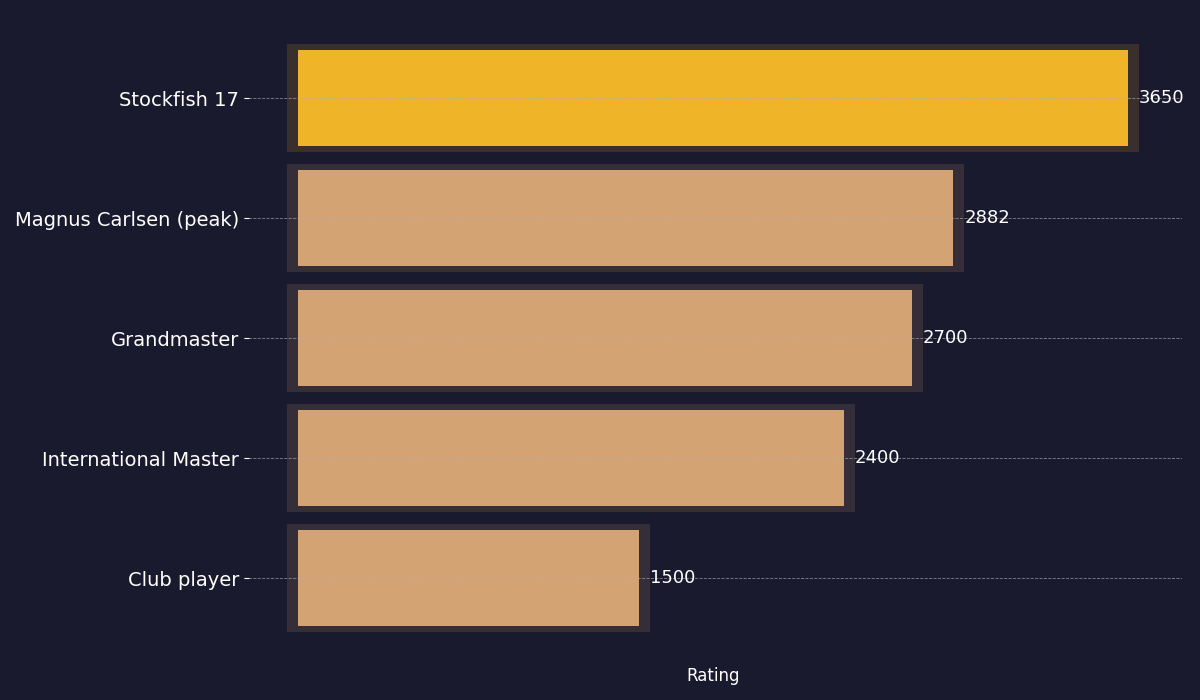Chess Engine 101
What you’ll learn: How engines think, which ones to use, and how to use them effectively. The essential starting point. Reading time: 12 minutes
A chess engine is software that calculates the best move in any position. The strongest engines—Stockfish, Leela Chess Zero, Komodo Dragon—play at roughly 3500 Elo, about 700 points above Magnus Carlsen’s peak rating. They’re not just strong; they’ve fundamentally changed how humans prepare and study the game.
This guide explains how engines work, which ones to use, and how to get the most out of them. If you’ve used engine analysis on Lichess or Chess.com but never really understood what’s happening under the hood, this is for you.
How engines think
Every engine does two things: search and evaluate.
Search means looking ahead. From any position, the engine generates legal moves, then generates responses to those moves, then responses to those, building a tree of possibilities. A modern engine on decent hardware might search 30-40 ply (15-20 full moves) deep in complex positions, examining millions of positions per second.
Evaluation means judging a position. At the leaves of the search tree, the engine assigns a score. Traditional engines use hand-crafted rules: material counts, king safety, pawn structure, piece activity. Neural network engines learn evaluation from millions of games.

The score you see—+1.23 or -0.45—is measured in “pawns.” Positive means White is better; negative means Black is better. But here’s the first thing to understand: engine scores are not predictions of the game result. A +1.5 evaluation means the engine assesses White’s position as equivalent to being up 1.5 pawns—not that White will definitely win. In closed positions or endgames with opposite-coloured bishops, even +2.0 can be a dead draw.
For a deeper dive into what engine numbers actually mean, see our guide to understanding evaluations.
The major engines

Stockfish
Stockfish is the strongest chess engine in the world and it’s completely free. Started as a fork of Tord Romstad’s Glaurung in 2008, it’s now maintained by a global community of developers who submit improvements through the Fishtest distributed testing framework.
In August 2020, Stockfish integrated NNUE (Efficiently Updatable Neural Network), a technology borrowed from Shogi engines. This hybrid approach—neural network evaluation combined with traditional alpha-beta search (examining moves deeply while pruning unpromising branches)—gave it a 100+ Elo jump overnight. It’s been dominant ever since, winning most TCEC (Top Chess Engine Championship) seasons.
Use Stockfish when you want: raw accuracy, fast analysis on CPU-only hardware, multi-line output for comparing variations.
Leela Chess Zero (Lc0)
Leela is the open-source answer to DeepMind’s AlphaZero. It uses a pure neural network trained through self-play—no human games, no hand-coded rules. The network learns patterns directly from playing millions of games against itself.
The catch: Leela needs a GPU to run at full strength. On CPU alone, it’s painfully slow. With a good GPU, it plays with a distinctly “human” style—long-term planning, positional sacrifices, quiet moves that don’t make sense until ten moves later.
Use Leela when you want: a second opinion that might see positional ideas Stockfish misses, especially in closed or strategic positions.
Komodo Dragon
Komodo was historically the main commercial alternative to Stockfish. The Dragon version incorporates MCTS (Monte Carlo Tree Search), the same search algorithm used by AlphaZero. It’s available in different personalities, including “Human” mode that deliberately plays more natural-looking moves.
Use Komodo when you want: analysis with a different search style, or human-like play for training.
The new wave
The NNUE revolution spawned dozens of strong open-source engines. Berserk, Caissa, Viridithas, and chess-rs all play at super-GM strength. They’re worth trying if you want alternatives to Stockfish or are curious about different approaches.
Which engine should you use?
Short answer: Stockfish.
For 95% of users, Stockfish is the right choice. It’s:
- The strongest engine available
- Completely free
- Runs on any computer (no GPU required)
- Supported by every chess application
The only reasons to use something else:
- Leela Chess Zero: For a second opinion in strategic positions (requires a good GPU)
- Komodo: For its “Human” mode in training games
If you’re reading this guide to learn about engines, start with Stockfish. You can always explore alternatives later. Tools like Chessmate let you run multiple engines and compare their evaluations side-by-side when you’re ready.
Using engines to improve
Engines are extraordinarily powerful, but they’re easy to use wrong. Here’s what actually helps:
Analyse your own games first. Before turning on the engine, go through your game and mark where you thought you went wrong. What were you trying to do? Where did your plan break down? Only then check with the engine. This way you’re testing your understanding, not just watching colours change from green to red.
Focus on critical moments. Don’t obsess over move 7 being second-best by 0.03 pawns. Look for the moments where evaluation swung—where you missed a tactic, chose the wrong plan, or mishandled a transition. Those are where you learn.
Explore alternatives. When the engine says your move was a mistake, don’t just play the engine’s suggestion on the board and move on. Ask why. Push the engine’s line forward. What was it threatening? What did your move allow? Understanding beats memorisation.
For practical workflows, see our guides on opening preparation and analysing your games.
Settings worth knowing
Most engine settings don’t matter for casual analysis. These few do:
Hash size controls how much memory the engine uses for its transposition table (a cache of previously calculated positions). Bigger is better, up to a point. Stockfish recommends setting hash to about half your available RAM. Too small and the engine forgets positions it’s already analysed; too big and your system slows down.
Threads determines how many CPU cores the engine uses. More threads = faster analysis. Set it to the number of cores you have (or cores minus one if you want your computer responsive for other tasks).
MultiPV (Multi Principal Variation) tells the engine to output more than one top move. Set MultiPV to 3 or 4 when you want to compare alternatives. Note that this makes analysis slightly weaker—the engine has to track multiple lines instead of focusing on the best one.
Contempt affects how the engine evaluates draws. Positive contempt makes it prefer playing on; negative contempt makes it more willing to accept draws. For analysis, contempt should usually be 0.
For deeper explanation of all options, see our engine settings guide.
Common misconceptions
“The engine says +3, so White is winning.” Not always. Engine evaluations assume both sides play perfectly from that point. Humans don’t. A +3 position with complicated tactics might be harder to convert than a +1 position with a simple plan. And some +3 positions are fortresses—technically better, but impossible to break through.
“I should always play the engine’s top choice.” The engine’s top choice is objectively strongest, but that doesn’t mean it’s best for you. In openings especially, the engine’s first choice is often a razor-sharp line requiring precise follow-up. The second or third choice might score better in practice because it’s easier to play.
“Higher depth means better analysis.” Mostly true, but with diminishing returns. Going from depth 20 to 25 might change the evaluation meaningfully. Going from depth 40 to 45 rarely does. For most analysis, depth 25-30 is plenty. Save the deep analysis for truly critical positions.
“Leela is better than Stockfish.” Neither is strictly “better.” Stockfish wins most direct matches at fast time controls. Leela occasionally finds deep strategic ideas that Stockfish misses. They’re different tools. The best practice is to check both when the position is unclear or strategically complex.
Going deeper
This guide covers the essentials. For more:
- Engine profiles: Stockfish · Leela Chess Zero
- Technical concepts: Understanding evaluations · NNUE explained · Tablebases
- Practical use: Opening preparation · Analysing your games · Engine settings
- History & culture: TCEC & CCRL ratings · The engine wars